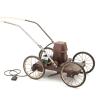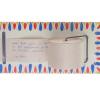Pre-fab - home-made
In the GDR, pre-fab materials were a key component in the Construction apartment blocks since the late 1950s. Between 1971 and 1989/90, more than two million appartments were built under the Honecker regime.
Among them was this special 11-storey “P 2” type - shown here as a model. It was made in leisure time by a resident of Eisenhüttenstadt in the 1980s and the contradictory of assembling a model in thousands of hours of leisure time which in reality was an object of industrial mass production is obvious and intriguing. The donor, who made this model, said he built it because he could not acquire a model kit at the time. His favourite models were actually sailing ships.
As he had nothing to do in his leisure time, he picked up on an idea to build this high rise which he and a relative passed daily on their way to their garden allotment. It was later displayed in the recreation room of his workplace - and it was suspected that the State Security (Stasi) had installed a microphone to monitor the workers’conversations during their lunch break. A microphone could not be found in the model but uneven cuts can be seen that the maker said weren´t his. Building models of used matches was a favourite leisure acitivity in the GDR and taught to boys in primary schools while the girls were instructed in needle work.
Most model building addicts stuck with pre-fabricated kits that were procured in the GDR (Plasticart Zschopau) and other Eastern countries. Most of these models were cars, aeroplanes and ‘Sputnik’ satellites were to be assembled from plastic parts or the traditional cut-out sheets (published by the official FDJ youth organization).
Model makers had their own publication in the GDR called Modellbau und basteln (Model-building and tinkering) which was published by the paramilitary “Gesellschaft für Sport und Technik” (Association for Sport and Technology).
 Previous Story
Next Story
Previous Story
Next Story
How to cite this page
Andreas Ludwig, 'Pre-fab - home-made', Inventing Europe, http://www.inventingeurope.eu/story/pre-fab-home-made
Sources
- Abc des Ostens. 26 Objektgeschichten, edited by Dokumentationszentrum Alltagskultur der DDR. Cottbus, 2003.
- Alltag: DDR. Geschichten, Fotos, Objekte, edited by Dokumentationszentrum Alltagskultur der DDR. Berlin: Ch. Links, 2012.
- Fortschritt, Norm & Eigensinn. Erkundungen im Alltag der DDR, edited by Dokumentationszentrum Alltagskultur der DDR. Berlin: Ch. Links, 1999.
- Guter Rat, Verlag für die Frau, Leipzig, 1965-1990 (formerly Guter Rat für heute und morgen).
- Kimmel, Elke. “Mit Sicherheit maßstabsgetreu. Objektgeschichte.” In Dokumentationszentrum Alltag: DDR. Geschichten, Fotos, Objekte, edited by Alltagskultur der DDR, 282-284. Berlin: Ch. Links, 2012.
- Krössin, Dominque. “Wie mach ich´s mir selbst? Die Zeitschrift practic und das Heimwerken.” In Wunderwirtschaft. Die DDR-Konsumkultur in den 60er Jahren, edited by the Neue Gesellschaft für bildende Kunst,160-165. Köln, Weimar, Wien: Böhlau, 1996.
- Magazin für Haus und Wohnung. VEB Verlag für Bauwesen Berlin.
- Merkel, Ina. Utopie und Bedürfnis, Die Geschichte der Konsumkultur in der DDR. Köln/Weimar/Wien: Böhlau, 1999.
- Practic. Verlag Junge Welt, Berlin, 1967-1990 (formerly: Modellbau und Basteln).
- Wunderwirtschaft. Die DDR-Konsumkultur in den 60er Jahren, edited by the Neue Gesellschaft für bildende Kunst. Köln, Weimar, Wien: Böhlau, 1996.




















